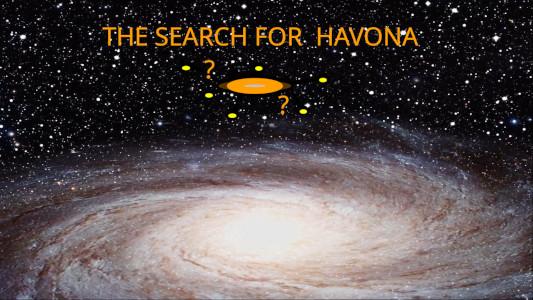Autor: Sławomir Żydenko
TABLE OF CONTENTS
Introduction
Explanation of Unknown Terms from The Urantia Book
The Grand Universe
Havona
Isle of Paradise
Master Universe
Brief Characteristics of Havona and the Isle of Paradise as the Seat of God
The search for an astronomical unit corresponding to the description of Havona and the Grand Universe
Immediate surroundings: Milky Way, Milky Way Subgroup, Local Galaxy Group
Virgo Cluster and Virgo Supercluster
Great Attractor and Supercluster Laniakea
Shapley Attractor and Shapley Supercluster
Vela Attractor and Vela Supercluster
Cluster VVVGCl-B J181435-381432
The solution to the problem of long distance to hypothetical Havona
Summary
Conclusion
Introduction
I welcome you to the next post explaining unknown astronomical terms from the Urantia Book. I encourage you also to read the previous posts with which today’s material is connected.
In previous materials, we have found that Urantia is the Earth, Nebadon is the surrounding part of the disk of the Milky Way, Orvonton is generally the Milky Way, and Uversa is an impossible to accurately locate object in the center of the Milky Way. Furthermore, I have provided links to the articles at the end.
Today’s episode is special because it deals with the physical presence of God in the universe. In order to locate this place, I will use quotations from The Urantia Book and confront them with current and widely available astronomical knowledge. I invite you all to read and comment.
Explanation of Unknown Terms from The Urantia Book
We already have an idea of the size of the Nebadon and the Orvonton superuniverse. We also know what Urantia is and where to look for Uversa. Now let’s move on to the quote from the Urantia Book, which is the main topic of this post. Here we find information about where God physically resides in the Universe:
“0:0.5 (1.5) (…) Orvonton is one of the seven evolutionary superuniverses of time and space which circle the never-beginning, never-ending creation of divine perfection—the central universe of Havona. At the heart of this eternal and central universe is the stationary Isle of Paradise, the geographic center of infinity and the dwelling place of the eternal God.
0:0.6 (1.6) The seven evolving superuniverses in association with the central and divine universe, we commonly refer to as the grand universe; these are the now organized and inhabited creations. They are all a part of the master universe, which also embraces the uninhabited but mobilizing universes of outer space.”
https://www.urantia.org/urantia-book-standardized/foreword
This passage is quite long, because it is about one thing. It concerns one great structure, larger than the Milky Way, called in the Urantia Book the grand universe, and an even bigger one, called the Master Universe.
We must explain what the Grand Universe, Havona, the Isle of Paradise, and the Master Universe are.
The Grand Universe
For a more complete characterization of the above structures and objects, I will quote excerpts from the following parts of the Book. The quote is from Paper number 15 and concerns the Grand Universe:
“15:2.2 (166.1) There are seven superuniverses in the grand universe, (…)
15:2.8 (166.7) 6. The Superuniverse. Ten major sectors (about 1,000,000,000,000 inhabitable planets) constitute a superuniverse. Each superuniverse is provided with an enormous and glorious headquarters world and is ruled by three Ancients of Days.
15:2.9 (166.8) 7. The Grand Universe. Seven superuniverses make up the present organized grand universe, consisting of approximately seven trillion inhabitable worlds plus the architectural spheres and the one billion inhabited spheres of Havona.”
https://www.urantia.org/urantia-book-standardized/paper-15-seven-superuniverses
It is clear from this quote that the Great Universe is seven structures comparable to the Milky Way and one special one called Havona. Whereby the Milky Way in the Urantia Book a superuniverse is.
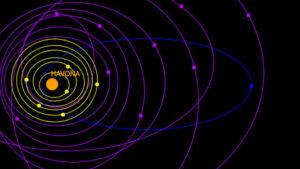
This is the diagram of the Grand Universe as described in The Urantia Book. Havona is marked in orange and the superuniverses and their orbits yellow.
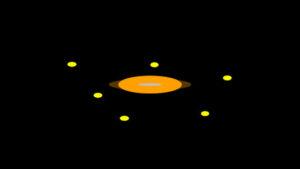
And here is my personal visualization of the Grand Universe. In the middle is Havona.
Havona
Here is another quote from Paper number 15 about Havona:
“15:3.3 (167.19) Observation of the so-called Milky Way discloses the comparative increase in Orvonton stellar density when the heavens are viewed in one direction, while on either side the density diminishes; the number of stars and other spheres decreases away from the chief plane of our material superuniverse. When the angle of observation is propitious, gazing through the main body of this realm of maximum density, you are looking toward the residential universe and the center of all things.”
https://www.urantia.org/urantia-book-standardized/paper-15-seven-superuniverses
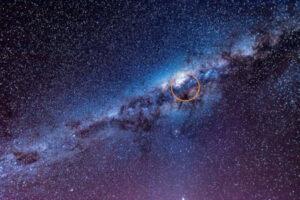
Behind the plane of the Milky Way’s disk and behind its center, there is the so-called Avoidance Zone, which is difficult to study.
Source of the graphics:
pixabay.com→varadannadate→space-6218022_1920.jpg
From this quote, I conclude that Havona is obscured by the main part of the Milky Way – „…gazing through the main body of this realm of maximum density…”. This zone includes the Constellations of Sagittarius, Serpentine, and Scorpio. If we want to find Havona and Isle of Paradise, we need to look for objects and structures near that location in the sky.
And one more quote describing Havona, this time from Paper number 12:
„12:1.10 (129.8) Havona, the central universe, is not a time creation; it is an eternal existence. This never-beginning, never-ending universe consists of one billion spheres of sublime perfection and is surrounded by the enormous dark gravity bodies. At the center of Havona is the stationary and absolutely stabilized Isle of Paradise, surrounded by its twenty-one satellites. Owing to the enormous encircling masses of the dark gravity bodies about the fringe of the central universe, the mass content of this central creation is far in excess of the total known mass of all seven sectors of the grand universe.”
https://www.urantia.org/urantia-book-standardized/paper-12-universe-universes
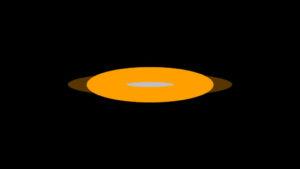
Could Havona look like this? As described in The Urantia Book, it should be one giant galaxy or possibly a group of galaxies. This graphic is only my personal idea of Havona.
From this passage, Havona is definitely more massive than the seven superuniverses. It acts as the center around which other galaxies or groups of galaxies, such as the Milky Way or the Local Group of Galaxies, orbit. From the text, we can conclude that Isle of Paradise does not orbit any other celestial body, meaning that it is at the center of the universe.
Isle of Paradise
Let’s read a few more passages about Isle of Paradise. They come from the eleventh Paper.
„11:0.1 (118.1) PARADISE is the eternal center of the universe of universes and the abiding place of the Universal Father, the Eternal Son, the Infinite Spirit, and their divine co-ordinates and associates. This central Isle is the most gigantic organized body of cosmic reality in all the master universe. Paradise is a material sphere as well as a spiritual abode. All of the intelligent creation of the Universal Father is domiciled on material abodes; hence must the absolute controlling center also be material, literal. And again it should be reiterated that spirit things and spiritual beings are real.”
https://www.urantia.org/urantia-book-standardized/paper-11-eternal-isle-paradise
I find the description of Isle of Paradise moving. It is defined as the largest object in the master universe. Characteristic is the phrase that „the absolute controlling center also (must) be material…”. From this passage it follows that if we had a suitable telescope, we should be able to see the Isle of Paradise, and therefore the seat of God. Let’s keep reading:
„11:1.2 (118.4) God dwells, has dwelt, and everlastingly will dwell in this same central and eternal abode. We have always found him there and always will. The Universal Father is cosmically focalized, spiritually personalized, and geographically resident at this center of the universe of universes.”
https://www.urantia.org/urantia-book-standardized/paper-11-eternal-isle-paradise
The idea of God being in a specific place in the Universe may be blasphemous to believers. To me, however, it is logical. Man is spiritual energy that resides in a material body. If we are created in the image of God, then God is also energy. Then this energy must also reside somewhere.
From the few quotations above we can infer where, according to The Urantia Book, the abode of God is—the central object in the universe called the Isle of Paradise. To find out where the abode of God actually is, we must locate the location of the Isle of Paradise.
And let’s continue to read the excerpts from Paper number 11.
„11:2.2 (119.3) In form Paradise differs from the inhabited space bodies: it is not spherical. It is definitely ellipsoid, being one-sixth longer in the north-south diameter than in the east-west diameter. The central Isle is essentially flat, and the distance from the upper surface to the nether surface is one tenth that of the east-west diameter.”
https://www.urantia.org/urantia-book-standardized/paper-11-eternal-isle-paradise
From this passage, it follows that the Isle of Paradise is characteristic. It has the shape of an elliptical disk.
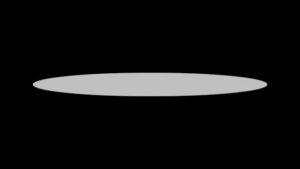
Here is a graphic based on the description in The Urantia Book, illustrating Isle of Paradise from the side.
Master Universe
Now, let’s now turn to the Master Universe. Let’s read a quote from Paper number 12, which characterizes the Master Universe a little more:
“12:1.11 (129.9) The Paradise-Havona System, the eternal universe encircling the eternal Isle, constitutes the perfect and eternal nucleus of the master universe; all seven of the superuniverses and all regions of outer space revolve in established orbits around the gigantic central aggregation of the Paradise satellites and the Havona spheres.”
https://www.urantia.org/urantia-book-standardized/paper-12-universe-universes
We read here that both the Superuniverses and the Master Universe circle Havona and Isle of Paradise, the abode of God, in a correlated manner. The subject of the Master Universe is very interesting and is described at length in Paper number 12. In short, it is the entire observable Universe and it is controlled by God. As an interesting fact, I will only add that, according to The Urantia Book, the universe has a center around which matter spins, but it also has boundaries. The universe is not infinite. The observable universe, according to The Urantia Book, resembles a gigantic galaxy in structure.

Diagram of the Grand Universe and the Master Universe as described in The Urantia Book. Orange for Havona, yellow for the superuniverses of the Grand Universe and their orbits, and purple for the galaxies of the Master Universe and their orbits.
Brief Characteristics of Havona and the Isle of Paradise as the Seat of God
From the above quotations, it follows that the master structure includes a total of seven equivalent superuniverses, such as Orvonton, and one special, central universe called Havona. In the middle of Havona is the Isle of Paradise, which is the seat of God. All seven superuniverses revolve around the central universe, that is, they are in its orbit. Not only that, but the entire observable universe revolves around Havona. The central universe attracts all seven superuniverses, and the entirety of the observable Universe, so it must be sufficiently massive.
The search for an astronomical unit corresponding to the description of Havona and the Grand Universe
So we are looking for a superior astronomical unit that could meet the above criteria.
Immediate surroundings: Milky Way, Milky Way Subgroup, Local Galaxy Group
On Wikipedia, we find the following astronomical units in which our Galaxy is located. Each subsequent unit is larger and contains the previous one.
Milky Way.
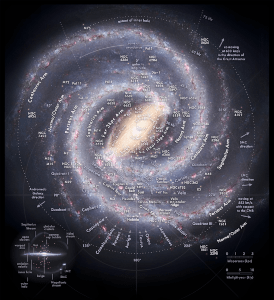
This is where we live.
https://en.wikipedia.org/wiki/Milky_Way
Subgroup of The Milky Way.
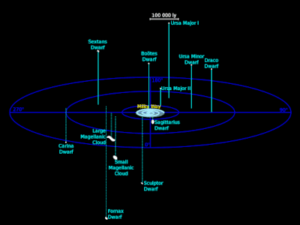
This is the Milky Way and its satellite galaxies. That’s definitely not what we’re talking about.
https://en.wikipedia.org/wiki/Satellite_galaxies_of_the_Milky_Way
Local Galaxy Group.
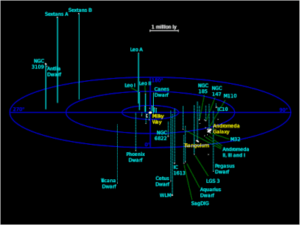
It is a dozen galaxies, of which the dominant are two – the Milky Way and Andromeda. This is absolutely not what we’re looking for.
https://en.wikipedia.org/wiki/Local_Group
Virgo Cluster and Virgo Supercluster
Virgo Supercluster. I quote from Wikipedia:
„The Virgo Supercluster or the Local Supercluster is a mass concentration of galaxies containing the Virgo Cluster and Local Group, which in turn contains the Milky Way and Andromeda galaxies. At least 100 galaxy groups and clusters are located within its diameter of 33 megaparsecs (110 million light-years). (…)
It has one rich galaxy cluster in the center, surrounded by filaments of galaxies and poor groups. (…)
The number density of galaxies in the Local Supercluster falls off with the square of the distance from its center near the Virgo Cluster, suggesting that this cluster is not randomly located.”
This is certainly the track number one. We have one massive galaxy cluster at the center, which is the Virgo Cluster about 54 million light-years away, and many smaller clusters orbiting around it, such as the Local Group of galaxies to which our Milky Way belongs.
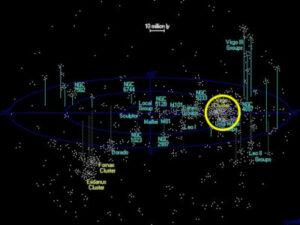
In this graphic, we see that the Virgo Cluster forms the highest density of stars. It creates the gravitational center of the structure.
https://en.wikipedia.org/wiki/Virgo_Supercluster
There is only one problem, the Virgo-Cluster is not even close to the center of the Galaxy, it is in a completely different place in the sky. Also, according to recent discoveries by scientists, the entire Virgo Supercluster appears to be in orbit around an object called the Great Attractor. On the other hand, in the Urantia Book, Havona is the center of the entire Universe, meaning that Havona does not orbit any other object.
Great Attractor and Supercluster Laniakea
Let’s deal with an even bigger astronomical unit, which is Laniakea. What does Wikipedia say about this? That’s a quote:
„The Great Attractor is a gravitational anomaly in intergalactic space and the apparent central gravitational point of the Laniakea Supercluster. The observed anomalies suggest a localized concentration of mass millions of times more massive than the Milky Way. However, it is inconveniently obscured by our own Milky Way’s galactic plane, lying behind the Zone of Avoidance, so that, in visible light wavelengths, the Great Attractor is difficult to observe directly.”
Sounds interesting, doesn’t it? However, there are two problems. First, the Great Attractor is admittedly obscured by our Galaxy, but not by its center. It is located in the direction of the constellation of the Southern Triangle and Norma. The distance is only estimated to be 150 to 250 million light-years from Earth. Second, there are doubts about the actual mass of the Great Attractor. According to some studies, the Great Attractor has only one-tenth of the initially estimated mass, and the Great Attractor itself, along with the Milky Way, is attracted toward the Shapley Attractor, located near the Shapley Supercluster.
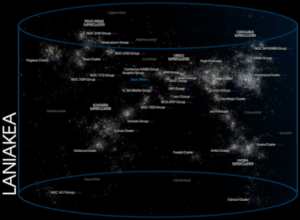
Laniakea Supercluster
By Andrew Z. Colvin – Own work, CC BY-SA 4.0,
https://commons.wikimedia.org/w/index.php?curid=71065242
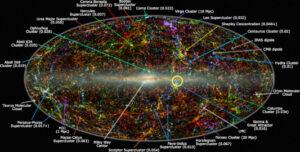
On this graphic is the Great Attractor marked.
https://en.wikipedia.org/wiki/Great_Attractor
https://en.wikipedia.org/wiki/Laniakea_Supercluster
Shapley Attractor and Shapley Supercluster
Let’s move on to the larger familiar structure. The Shapley Supercluster is located in the Centaurus Constellation. It is visually close to the center of the galaxy, as described in the Urantia Book. However, it is very far behind it, namely 650 million light-years from Earth. Please listen to a quote from the Wikipedia:
„The Shapley Supercluster or Shapley Concentration (SCl 124) is the largest concentration of galaxies in our nearby universe that forms a gravitationally interacting unit, thereby pulling itself together instead of expanding with the universe. It appears as a striking overdensity in the distribution of galaxies in the constellation of Centaurus. (…)
The Shapley Supercluster lies very close to the direction in which the Local Group of galaxies (including our galaxy) is moving with respect to the cosmic microwave background (CMB) frame of reference. This has led many to speculate that the Shapley Supercluster may indeed be one of the major causes of our galaxy’s peculiar motion—the Great Attractor may be another—and has led to a surge of interest in this supercluster. It has been found that the Great Attractor and all the galaxies in our region of the universe (including our galaxy, the Milky Way) are moving toward the Shapley Supercluster.” End of quote.
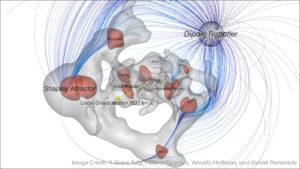
On this graphic you can see the size of the Shapley Supercluster.
https://en.wikipedia.org/wiki/Shapley_Supercluster
https://en.wikipedia.org/wiki/Shapley_Attractor
https://youtube.com/watch?v=NpV0GQo3P0c
https://web.archive.org/web/20130131095725/
http://wszechswiat.astrowww.pl/superc/shapley.html
According to the Wikipedia description, The Shapley Supercluster fits to be the center of the Universe, that is, matter is attracted to it, and itself is not in any orbit. This is a very interesting track, although there are some doubts too – it’s visible. In a passage from the Urantia Book, we read that:
“15:3.3 (167.19) (…) When the angle of observation is propitious, gazing through the main body of this realm of maximum density, you are looking toward the residential universe and the center of all things.”
https://www.urantia.org/urantia-book-standardized/paper-15-seven-superuniverses
It is clear from this passage that when we look at the densest parts of the Milky Way we are only looking toward the center of all things, but we cannot see it because it is obscured by the Milky Way disk.
This condition is fulfilled by an even more distant structure, namely the Vela Supercluster.
Vela Attractor and Vela Supercluster
The Vela Supercluster is located 800 million light years away, and all indications are that it is at least as massive, if not more, than the Shapley Supercluster. It is gigantic, and in addition, it is partially obscured by the Milky Way disk. If it turns out that the structure is actually that big, it could be the Havona of the Urantia Book.
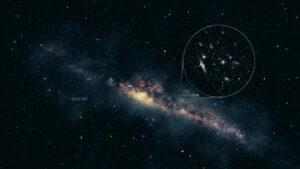
The problem with the Vela Supercluster, however, is that it is still under-explored – no wonder, it is obscured by the disk of our Galaxy. Besides, it is not located behind the center of the Milky Way, but behind its disk.
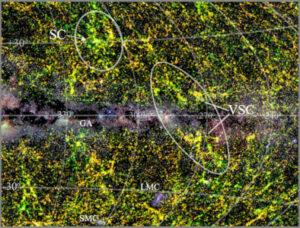
https://www.quantamagazine.org/hidden-supercluster-could-solve-milky-way-mystery-20171121/
https://www.universiteitleiden.nl/en/news/2016/11/enormous-supercluster-of-galaxies-discovered
https://en.wikipedia.org/wiki/Vela_Supercluster
Cluster VVVGCl-B J181435-381432
So let’s move even further. At the end of 2022, using modern methods, researchers discovered a galaxy cluster directly behind the center of the Milky Way. This cluster is called VVVGCl-B J181435-381432 and is located 2.7 billion light-years away. For now, there is no question of finding the presence of a gravitational center that we are looking for. The whole hope, however, is that humanity already has observational methods that allow us to observe what lies behind the center of the Milky Way.
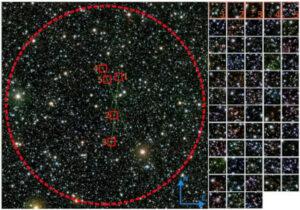
So far, a small section of space behind the Galactic Center has been studied.
https://arxiv.org/abs/2210.16332
https://arxiv.org/pdf/2210.16332.pdf
Unfortunately, it is impossible to determine with certainty where Havona is in the sky with Isle of Paradise in the middle, due to the lack of sufficient astronomical data. One must take into account that the Avoidance Zone is large, and the largest unknown space is behind the core of our Galaxy. Havona should be located right there, if we were to take literally and precisely what is written in The Urantia Book.
The solution to the problem of long distance to hypothetical Havona
None of the nearby space structures match the description of Havona in The Urantia Book. The distant structures don’t match one hundred percent either, but we can assume that Havona is far away rather than close. In the Urantia Book, the Grand Universe is repeatedly referred to as a great creation. However, problems of a logical nature are associated with a long distance. The entire habitable universe, as described in the Urantia Book, is limited to one center called Havona and basically seven galaxies, comparable to the Milky Way. The galaxy is only in our concept of large, in the cosmic scale it is like a grain of sand. Even a cluster of galaxies on a cosmic scale is not large. On a cosmic scale, only a cluster of clusters, as, for example, the Virgo Supercluster, to which we belong, can be considered as a large unit.
And here is the problem. It is a question of precisely these seven galaxies. A huge creation consisting of seven galaxies and yet scattered over hundreds of millions of light-years at different ends of it? With such vast distances, it looks as if the Roman Empire consisted of one city and seven villages scattered at different ends of the empire. Such an empire would not be called inhabited, but rather uninhabited.

This graphic is a visualization of the scientist’s findings. In this graphic, the largest bubble is the largest gravitational center. The Local Group is just a small dot. In no way can it be described as one seventh of what we see in the image.
https://youtube.com/watch?v=NpV0GQo3P0c
Some solution to this problem is given by the following phrase from the sixth sentence of the preface 0:0.6 (1.6): „Seven evolving superuniverses…”. Namely, superuniverses occur in principle constantly together with the term „evolving”. So it is possible that the superuniverses are at the beginning of evolution and that for one inhabited galaxy there are thousands of uninhabited ones.
Also interesting is the sentence in Paper 15 suggesting that the superuniverses are isolated from each other, here is the quote:
“15:10.23 (179.10) The superuniverses do not maintain any sort of ambassadorial representation; they are completely isolated from each other. (…) This isolation of the superuniverses will persist until such time as their co-ordination is achieved …”
https://www.urantia.org/urantia-book-standardized/paper-15-seven-superuniverses
So it may be that one inhabited galaxy is surrounded on each side, for isolation, by uninhabited galaxies.
The question of the great distance from Havona as the center of the grand universe may be related to the vortex motion to which matter in the universe is subjected. The orbit of our Galaxy around the Attractor does not have to be circular at all, it can be elliptical, and therefore the galaxy once approaches the center, and once it is thrown into the space of the Universe. Therefore, our world may have been close to the center and may return to it again one day.
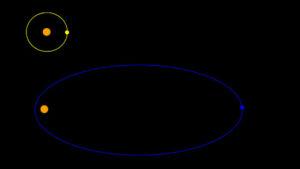
The difference between a circular orbit and an elliptical orbit. There’s an elliptical orbit down there. A physical body in such an orbit is approaching once and once moving away from the center.
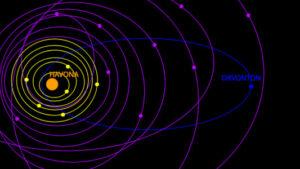
Notice the blue orbit. If Orvonton follows such an orbit around Havona, the great distance to Havona becomes explicable.
The following quote from Paper number 15 can serve as indirect confirmation of this thesis. In it we read that other superuniverses are closer to Havona:
“15:1.6 (165.5) Urantia belongs to a system which is well out towards the borderland of your local universe; and your local universe is at present traversing the periphery of Orvonton. Beyond you there are still others, but you are far removed in space from those physical systems which swing around the great circle in comparative proximity to the Great Source and Center.”
https://www.urantia.org/urantia-book-standardized/paper-15-seven-superuniverses
Note the second part of the second sentence: “… you are far removed in space from those physical systems which swing around the great circle in comparative proximity to the Great Source and Center.” With “Great Source and Center” being a term used for God (located on the Isle of Paradise).
https://www.urantia.org/urantia-book-standardized/paper-15-seven-superuniverses
Summary
So, based on the scientific data available to me, I cannot find structures and objects that correspond one hundred percent to Havona and therefore to Isle of Paradise as described in The Urantia Book. According to the description in the Book, it is located behind the impenetrable center of our Galaxy. But the fact that these objects are not visible, does not mean that they are not there. Perhaps they are, we just can not confirm their existence.
Maybe just wait a few years and the mysteries of the Urantia Book will be solved. That being said, I haven’t solved the mystery of where exactly God is either. Certainly, his abode is far away. But at the same time, he is also close. According to the teachings of the Church, we have a particle of God within us, and that is more or less what the Urantia Book also says.
The awareness of the existence of a powerful God, who rules the Universe, who is our Creator and Father, is relaxing for me, but also sobering. It means that our existence must have some meaning. An intelligent being ruling a world of this magnitude would not allow himself to act without meaning. And does this mean that it will be easy for us to meet the expectations of such a Father? I don’t think so.
The data in the Urantia Book can be taken on faith to be true or not. However, it is the same with the data of astronomers – you can believe it or you can disbelieve it. An example is the Great Attractor, at first it is great, and after a few years it is no longer. Another example is the diameter of our Galaxy, which according to scientists is one hundred, two hundred or two million light-years.
I can draw one very important conclusion. Namely, that the common in both sources is that there is some kind of gravitational center behind our Galaxy. Both sources say that, both the Urantia Book and modern astronomical science. Only that in the Urantia Book you could read about it in the fifties of the last century. The Great Attractor was first talked about by scientists 20 years later, in the 1970s, while about the Shapley and Vela gravitational anomaly astronomers began to talk only for several years. Only the distance at which this Attractor is located is an open question. Unfortunately, the Urantia Book does not say directly or indirectly how far Havona is. At least I have not been able to find information on this.
It is also possible that scientists misinterpreted the location of the Attractor. Anything is possible. After all, modern science does not even have a clear idea of how the universe came into being and how it is built.

Behind the disk of the Milky Way are objects with strong gravity. The following abbreviations are used in the graphic:
VSC: Vela Supercluster; SC: Shapley Supercluster; GA: The Great Attractor; LMC: The Large Magellanic Cloud; SMC: Small Magellanic Cloud.
https://www.urania.edu.pl/wiadomosci/dostrzezono-supergromade-galaktyk-schowana-za-droga-mleczna-2609.html
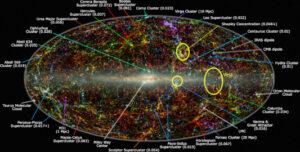
https://en.wikipedia.org/wiki/Great_Attractor
Here are the gravitational anomalies marked on the sky map – The Great Attractor, the Shaplay Supercluster and the Vela Supercluster.

From the Urantia Book data I present my personal idea of what the Grand Universe, Havona, the Isle of Paradise, and the Master Universe might look like. Colors only serve to distinguish individual elements:
Silver: the Isle of Paradise – a giant object of extraordinary gravity that is the center of the Universe.
Orange: Havona is a giant galaxy surrounding the Isle of Paradise.
Yellow: inhabited superuniverses, galaxies comparable to the Milky Way, near Havona and their orbits.
Blue: Orvonton, or the Milky Way and its orbit, away from Havona. The Milky Way belongs to inhabited galaxies.
Violet: the uninhabited galaxies of the outer Master Universe and their orbits. These galaxies are not different, except that, there is no life on them.
And now the image of Havona and the Grand Universe presented a little more realistically:
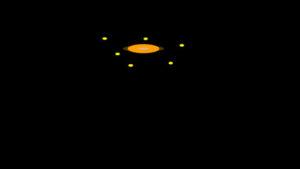
And then there’s the image of Havona and the Grand Universe presented as if we had jumped out of our Galaxy and could observe Havona and the Grand Universe unhindered:
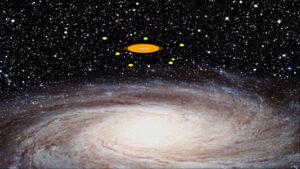
Conclusion
My dear readers, I started this series of articles with a conviction that I will explain all puzzles easily. It turned out that nothing was easy. The subject turned out to be so difficult that I stuck with it for many months. However, it was an amazing adventure for me. At first, after reading the Urantia Book, I obviously had some ideas. In the end, after detailed analysis, I came to conclusions that surprised me. At the beginning, the data from the Urantia Book was a bit questionable for me in some places. It was only at the end, when analyzing the Master Universe, that all the pieces of the puzzle began to fit for me. There are many more unexplained astronomical phenomena described in The Urantia Book. It seems, that seventy years after its publication, The Urantia Book is still ahead of science.
I hope you have enjoyed reading this post and that it has brought at least some more clarity to the subject. I also hope that I’ve piqued the interest of the Urantia Book for those who are encountering it for the first time.
Read The Urantia Book for yourself. You can download it in different languages for free from the official www.urantia.org website. Analyze for yourself and write in the comments what you think. Until next time, best regards!
Link to the video:
https://youtu.be/WM8T5Gk8CRY
Link to the first part:
https://urantia.online/en/god-the-universe-and-other-planets-the-urantia-book-foreword_1/
Link to the second part:
https://urantia.online/en/urantia-is-earth-nebadon-is-fragment-of-the-milky-way/
Link to the third part:
https://urantia.online/en/orvonton-is-the-milky-way-subgroup/
Link to the fourth part:
https://urantia.online/en/uversa-is-an-object-in-the-center-of-the-galaxy/
Facebook:
https://www.facebook.com/slawomir.zydenko/
Quotes sources:
https://www.urantia.org/urantia-book-standardized/foreword
https://www.urantia.org/urantia-book-standardized/paper-15-seven-superuniverses
https://www.urantia.org/urantia-book-standardized/paper-12-universe-universes
https://www.urantia.org/urantia-book-standardized/paper-11-eternal-isle-paradise
https://en.wikipedia.org/wiki/Milky_Way
https://en.wikipedia.org/wiki/Satellite_galaxies_of_the_Milky_Way
https://en.wikipedia.org/wiki/Local_Group
https://en.wikipedia.org/wiki/Virgo_Supercluster
https://commons.wikimedia.org/w/index.php?curid=71065242
https://en.wikipedia.org/wiki/Great_Attractor
https://en.wikipedia.org/wiki/Laniakea_Supercluster
https://en.wikipedia.org/wiki/Shapley_Supercluster
https://en.wikipedia.org/wiki/Shapley_Attractor
https://youtube.com/watch?v=NpV0GQo3P0c
https://web.archive.org/web/20130131095725/
http://wszechswiat.astrowww.pl/superc/shapley.html
https://www.quantamagazine.org/hidden-supercluster-could-solve-milky-way-mystery-20171121/
https://www.universiteitleiden.nl/en/news/2016/11/enormous-supercluster-of-galaxies-discovered
https://en.wikipedia.org/wiki/Vela_Supercluster
https://arxiv.org/abs/2210.16332
https://arxiv.org/pdf/2210.16332.pdf
https://www.urania.edu.pl/wiadomosci/dostrzezono-supergromade-galaktyk-schowana-za-droga-mleczna-2609.html
Source of thumbnail graphics:
https://vimeo.com/345170895
and own.
Support:
https://urantia.online/en/support

